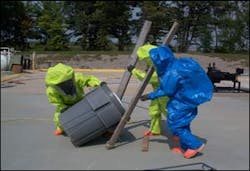Hazmat in the Trenches: Drum Overpacking
Drum handling is a common emergency in the hazmat response world. It is one in which our skills can be tested because of the sheer weight of full drums and because it can be awkward. Drums, being round and weighing upwards of 700 hundred pounds, challenge responders and also because problems with drums frequently occur in tight spots such as in the back of a van trailer or in a crowded warehouse.
Handling drums also present physical problems of pinched fingers and toes and even the higher risk of back injuries. Consequently, some teams have found ingenious ways to work smarter and not harder when it comes to handling heavy drums.
The typical method of handling drums is simply called the "bull work" method where responders use their backs and brawn to handle the drum and move it where they want it to go. Injuries that have occurred with this method include strained backs and shoulders. The drum may also pay the price when gravity takes hold and the drum cannot be controlled by responders when lowering it to the ground. (see photo 1)
A better way of handling drums is called the "leverage" method and it entails using two-by-four-inch boards that are approximately eight feet long along with some rope or webbing. The boards are placed on either side of the drum that is to be raised or lowered and the rope or webbing is securely attached to the boards to form a saddle where the drum will rest during movement. The rope or webbing is spaced so it cradles the drum equally. (see photo 2)
By placing the boards with attached rope or webbing behind the drum it is ready to move using leverage to the responder's advantage. Responders will need to lean the drum backwards into the rope saddle and then firmly grasp the boards near the end to realize the full effect of the leverage. Careful lowering completes the first phase of overpacking. (see photo 3)
There are several methods of overpacking the drum at this point such as the rolling V method, or the grunt method where responders use sheer brute strength to push the drum into the overpack. The smart method is to again use leverage and employ a small two-by-four-inch board. The drum will need to be rolled onto the small board at about the middle of the drum. Once on top of the board a responder can lean on the drum in order for one end to raise high enough where the overpack drum can be brought in under and around the drum. The other responder will need to push the overpack as far over the drum as possible. (see photo 4)
At this point, the tendency will be to "bull" the drum into the overpack but leverage can prevail here again. Place the boards with the attached ropes along side the drum that is nearly inside the overpack and simply roll the whole unit into the saddle. At this point the responders can grasp the boards near the ends and begin lifting. As they lift, the drum will be lowered into the overpack. (see photo 5)
Use of this method has been known to save backs and prevent injuries. It has been used successfully in the back of over-the-road semi-trailers and even in tight warehouses because it needs little space to move drums. It is a proven method that can work for you also. It just needs a few inexpensive pieces of equipment and some practice during training sessions. Good luck with this and be safe!
The author would like to thank the Midland, MI, Fire Department's hazmat team members for their participation in the drum handling and overpacking drill.
As usual, any and all comments are welcome. Please contact the author at [email protected] or at the website www.hazmatpetie.com.
DAVID PETERSON, a Firehouse.com Contributing Editor, is a 26-year fire service veteran who serves as an officer on Ladder 6 in Madison, WI, and as the Operations and Training Director for the department's regional Level A HazMat team. David founded the Wisconsin Association of Hazardous Materials Responders, Inc. and teaches, presents, and authors articles on a wide variety of hazmat topics. David is also a National Fire Academy instructor of chemistry and a Master Instructor for the International Association of Fire Fighters HazMat and Terrorism training programs. To read David's complete biography and view their archived articles, click here. You can reach David by e-mail at [email protected].
